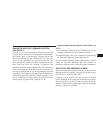
empty or is occupied by someone that is classified in the
“child” category. This could be a child, a teenager, or
even a small adult.
Here are some simple steps you can take to minimize the
risk of harm from a deploying airbag.
1. Children 12 years old and under should always ride
buckled up in a rear seat.
Infants in rear facing child restraints should NEVER ride
in the front seat of a vehicle with a passenger front airbag.
An airbag deployment can cause severe injury or death to
infants in that position.
Children that are not big enough to properly wear the
vehicle seat belt (see Section on Child Restraints) should
be secured in the rear seat in child restraints or belt-
positioning booster seats. Older children who do not use
child restraints or belt-positioning booster seats should
ride properly buckled up in the rear seat. Never allow
children to slide the shoulder belt behind them or under
their arm.
You should read the instructions provided with your
child restraint to make sure that you are using it properly.
2. All occupants should wear their lap and shoulder belts
properly.
3. The driver and front passenger seats should be moved
back as far as practical to allow the front airbags room to
inflate.
4. If your vehicle has side airbags, do not lean against the
door, airbags will inflate forcefully into the space be-
tween you and the door.
5. If the airbag system in this vehicle needs to be
modified to accommodate a disabled person, contact the
Customer Center. Phone numbers are provided under ЉIf
You Need AssistanceЉ in Section 9 of this manual.
THINGS TO KNOW BEFORE STARTING YOUR VEHICLE 93
2


















